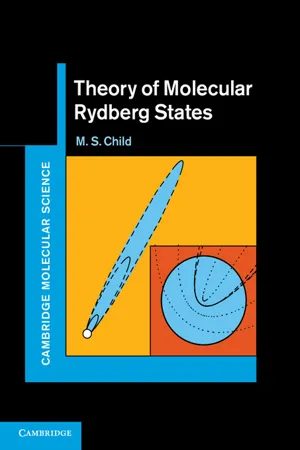Theory of Molecular Rydberg States
About this book
Molecular Rydberg states have many unusual properties, lending themselves to a diverse range of experimental applications. This book is designed to unravel the mysteries of molecular Rydberg states that lie beyond the scope of accepted spectroscopic theories. It is the first single-authored text to focus on the application of multi-channel quantum defect theory (MQDT) and ab initio theory to this special class of molecular systems, introducing readers to novel theoretical techniques. The scattering techniques of MQDT are examined, along with a unified description of bound states and fragmentation dynamics. Connections with established spectroscopic theory are also described. The book concludes with an account of the spherical tensor and density matrix theories required for the interpretation of multi-photon experiments. While the main text focuses on physical principles and experimental applications, appendices are used to handle advanced mathematical detail. This is a valuable resource for researchers in chemical, atomic and molecular physics.
Frequently asked questions
- Essential is ideal for learners and professionals who enjoy exploring a wide range of subjects. Access the Essential Library with 800,000+ trusted titles and best-sellers across business, personal growth, and the humanities. Includes unlimited reading time and Standard Read Aloud voice.
- Complete: Perfect for advanced learners and researchers needing full, unrestricted access. Unlock 1.4M+ books across hundreds of subjects, including academic and specialized titles. The Complete Plan also includes advanced features like Premium Read Aloud and Research Assistant.
Please note we cannot support devices running on iOS 13 and Android 7 or earlier. Learn more about using the app.
Information
Table of contents
- Cover
- THEORY OF MOLECULAR RYDBERG STATES
- Cambridge Molecular Science
- Title
- Copyright
- Contents
- Preface
- 1 Molecular Rydberg states
- 2 The quantum defect picture
- 3 Ab-initio quantum defects
- 4 Frame transformations and channel interactions
- 5 Competitive fragmentation
- 6 Photo-excitation
- 7 Photo-ionization
- 8 Manipulating Rydberg states
- Appendix A: MQDT normalization
- Appendix B: Alternative MQDT representations
- Appendix C: Rotational frame transformations
- Appendix D: Optical transition and photo-ionization amplitudes
- Appendix E: Generalized MQDT representation
- Appendix F: Notation
- Index
